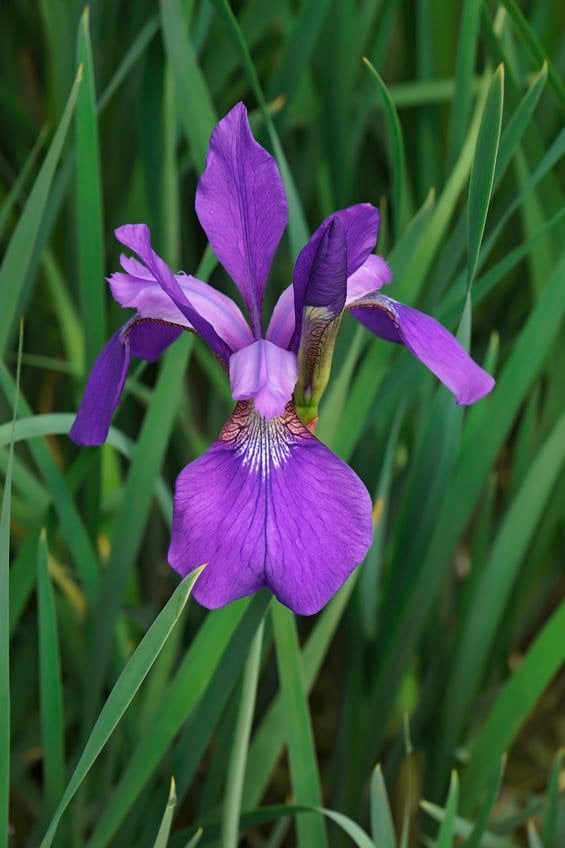Irises are highly popular flowers in many gardens and for good reason – they’re hardy, reliable, and beautiful. Many gardeners prefer them because, in addition to being graceful and colorful – after all, the word “iris” means “rainbow” in Greek -- they attract butterflies and hummingbirds.
Among the over 300 species of irises worldwide, Siberian Irises in particular are popular because they are among the easiest to grow in a temperate climate like ours, easily adapting to USDA Plant Hardiness Zones 3 to 8. While the name might sound like they prefer a colder climate, they are in fact a group of hybrid flowers developed from two blue-flowered Asian species. The Siberian Iris (Iris sibirica) sports amazingly long lasting flowers in a cool and consistent spring. Too much rain and heat will wilt flowers prematurely. The most common is ‘Caesar’s Brother’ (photo).
How to divide Siberian iris
They come in a variety of other colors and combinations -- white, light blue, lavender -- but they all feature the same growth habit and behavior in the garden, even though the flowers are different colors and sizes. Iris sibirica works well in a wide variety of gardens -- from simple garden borders to complex perennial gardens. This plant is comfortable in conditions ranging from part shade and boggy gardens to wet sites. It’s just a super easy plant to grow with very little effort. I recommend playing with several colors and making a wonderful spring show of color.
Managing your irises for better flowering and growth
 While there are so many great things about irises, they have a dark side as well. Despite being so easy to grow and being so comfortable in many gardens, Iris sibirica grows big and can often outpace its bedfellows, effectively elbowing aside slower plants. When it starts to take up too much room, it can develop a dead center and will reduce its own flower production. That’s when it’s time to divide.
While there are so many great things about irises, they have a dark side as well. Despite being so easy to grow and being so comfortable in many gardens, Iris sibirica grows big and can often outpace its bedfellows, effectively elbowing aside slower plants. When it starts to take up too much room, it can develop a dead center and will reduce its own flower production. That’s when it’s time to divide.

Make no mistake about it -- dividing Siberian iris is a physical job. It takes some serious effort because the plant gets deeply rooted and tenacious. It will not give up easily. I actually end up jumping on my nursery spade to get a good cut all around the outside of the plant. Then it becomes necessary to use some muscle and leverage to pry the plant out of the ground.
The best times of the year to divide an iris are October to early November and late March through April – basically as soon as the ground is thawed in the spring. It will be a big, heavy clump so it can be hard to get out of the hole without help. This is when I bless my younger staff for their able assistance. Sometimes, if left on my own, I just divide the plant right in the hole without pulling it out. A heavy nursery spade or sharp edger are great for this. But, by far, the very best tool to divide an old and entrenched Siberian Iris is a super sharp axe. Like I said, this is serious business.

TWEETABLE TIP
Video: How to divide Siberian Iris -- Make no mistake about it -- it’s a physical job, but worth it. These graceful, tall, colorful plants are a showstoppers in the spring garden.
VIA @GardenContinuum

Once divided, you’ll simply plant one healthy section in the hole it came out of. If the soil looks thin and lacking, add some rich compost and plan to water it well and often -- one to two times a week for about 3 to 4 weeks after the transplant to keep the plant hydrated. Then you should be fine to monitor its condition and only water as needed.
Plan to plant your divided iris immediately so that the divided sections can be cared for well. If you have no place to plant these divisions, pot them up and give them to friends and neighbors. You can always donate them to churches, temples, and community centers that could use good plants and a pop of color in their garden each spring. These are such easy plants to care for that they make great gifts.
Siberian Irises – if you haven’t grown them before, I highly recommend you give them a place in your garden. These graceful, tall, colorful plants are a great backdrop for other early spring flowers, as well as showstoppers on their own. Need more tips? Consider downloading the eBook titled "Demystify Your Landscape: Picking Plants."

Image Copyright: 123RF Stock Photo








Leave a comment